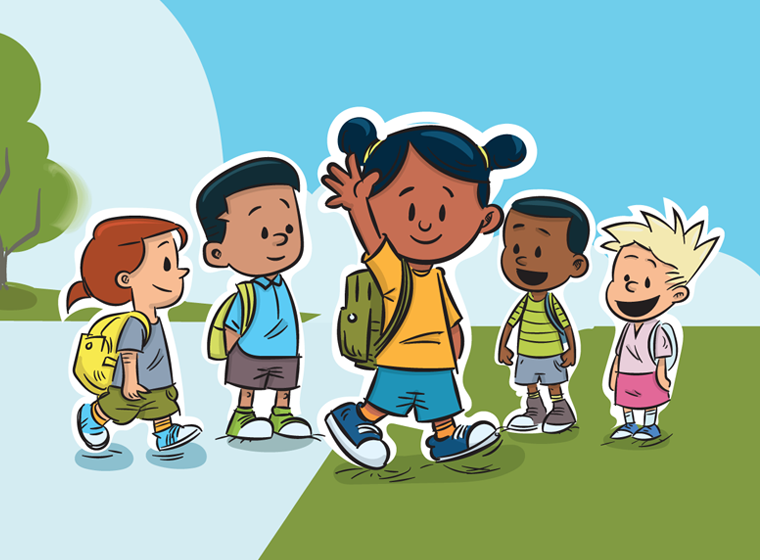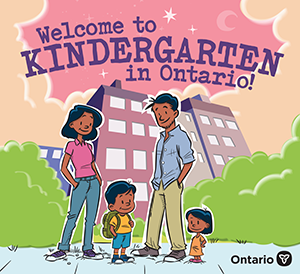Overview
Kindergarten is the start of your child’s education journey. It gets your child ready for Grade 1 and sets them up to be successful for future learning.
Your child will have learning opportunities to investigate, problem solve and collaborate as they make sense of the world around them.
Kindergarten is a free 2-year program for 4- and 5-year-old children. When children turn 6 years old, they must attend school in September of that year.
Benefits for your child
Kindergarten gives your child a stronger start in school by:
- improving early reading, writing and math skills
- providing a strong foundation for future learning
- making the transition to Grade 1 easier for both you and your child
Your child will have more time with classmates, which helps them to:
- socialize with other children
- develop social and foundational skills for future success
Resources for parents
Get resources, activities and practical tips to support your child’s learning at home.
Books and activities for the first day of school
Explore a collection of eBooks from the Ministry of Education, perfect for reading with your child to get excited for the first day of school.
- Amir’s first day of kindergarten (ePub)
- Amira’s first day of kindergarten (ePub)
- Amir’s first day of kindergarten (PDF)
- Amira’s first day of kindergarten (PDF)
To view as an eBook, download the ePub file and open it in an e-Reader app like Apple Books, Google Play Books, Thorium Reader or others.
Download and print our free activity book to keep your child entertained and creatively engaged (PDF).
Get ready for kindergarten
Find practical advice and helpful tips for preparing your child for kindergarten, including tips for:
- toilet training
- getting your child ready and excited to start school
- supporting your child’s learning at home
Kindergarten explained
Understand your child’s kindergarten report card, which is called a communication of learning.
Classroom activities
Classroom activities help children learn through teaching, play and inquiry.
Play-based learning is designed to help children develop a strong foundation for learning in all areas including:
- problem solving and creative thinking
- thinking critically about ideas and information in literacy and math
- learning to think for themselves, understanding their feelings and those around them, recognizing and respecting differences in others, and assessing the consequences of their actions
- understanding their connections, contributions and relationships with others as part of a group, a community and the natural world
- developing socially and emotionally through their relationships with other children and the educators who guide them
- developing as a citizen, through a sense of personal connectedness to various communities, like their class and their school
You will receive regular updates on your child's learning in many ways, such as:
- informal meetings with the educator team, including chatting after school, phone calls, notes, home-school communication books
- school and class websites, newsletters, blogs, apps
- parent-teacher or parent-teacher-student conferences
- written communication of learning reports
Kindergarten curriculum update
The Ontario Curriculum, Kindergarten, 2026 will replace The Kindergarten Program, 2016. Starting in the 2026-27 school year, all kindergarten programs will be based on the expectations outlined in the 2026 curriculum policy.
Your child’s educator team
In kindergarten classrooms with more than 16 students, an educator team is made up of:
- a teacher
- an early childhood educator
They work together to help your child learn in a safe and healthy learning environment.
Teachers understand the elementary curriculum and how to assess student progress. They have a knowledge of the broader elementary curriculum, assessment, reporting and child development. They are responsible for:
- instruction and student learning
- evaluation
- formal reporting to parents
Early childhood educators (ECEs) are trained in early childhood development. They understand and implement the kindergarten curriculum, focusing on age-appropriate planning that promotes each child’s:
- physical, cognitive, language, emotional, social and creative development
- well-being
Transportation
Your school board may provide transportation to and from school during regular school hours, for example arriving at school at 8:45 a.m. and leaving the school to go home at 3:15 p.m.
You are responsible for arranging for transportation if you choose to send your child to school at different times. This includes getting your child to and from before- and after-school programs.

